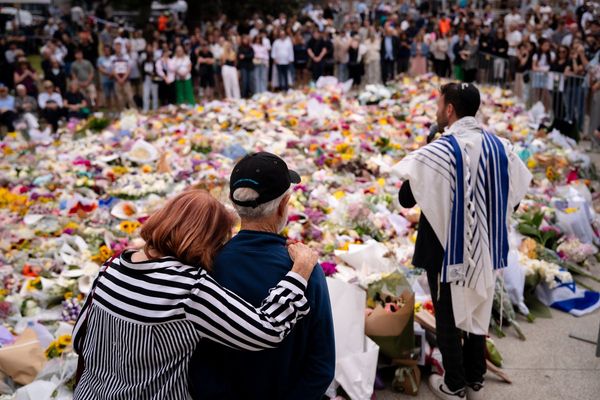
There’s a reverent kind of hush at Melbourne’s Heide Museum of Modern Art. Between the grey walls, Barbara Hepworth’s modernist sculptures are artfully arranged. Attenders wind their way through the maze, backdropped by black and white photographs of Hepworth at work. Occasionally, a comment will cut through the silence. Hepworth’s famous stringed sculptures, one woman observes to her friend, cast shadows on the walls, but in the shadows, only the “eye” is visible – the strings disappear. What is seen in the physical space, and what is seen as silhouette, are two separate forms.

Co-curators Lesley Harding and Kendrah Morgan travelled to the UK in 2018 to begin the process of putting In Equilibrium together. It’s the first time Hepworth’s work has been shown in a major exhibition in Australia, and includes more than 40 works from national, international and private collections – a fraction of the 600-odd sculptures in the prolific late British artist’s oeuvre.
This major survey is significant, especially considering the way in which Hepworth was overlooked in her lifetime. Her contemporary, Henry Moore, has often been mistakenly credited with inventing Hepworth’s famous piercing of the form, which places a literal hole in the sculpture. The technique, which Hepworth introduced in 1931, has had an enduring influence on modern abstract sculpture.
With the shifting social tides over the last decade, the sculptor is finally getting her due. “We’ve had a real push to bring back into the spotlight the work of women artists who have been neglected, or a full acknowledgment of their achievements has not necessarily come about,” says Harding, who is also artistic director of Heide. “Hepworth’s work really still feels very contemporary and fresh, and speaks to our current times with themes that are very universal.”
In Equilibrium traces the development of the artist’s style – she worked across stone, wood, bronze and more in both polished and raw forms over half a century. It’s fascinating seeing the patterns and themes within Hepworth’s cerebral work, particularly within the select paintings and drawings exhibited – two-dimensional sketches that are, Harding clarifies, not preparatory prototypes for the sculptures but rather an exploration of similar ideas. As Hepworth herself said: “Halfway through any work, one is often tempted to go off on a tangent. Once you have yielded, you will be tempted to yield again and again … Finally, you would only produce something hybrid.”

Certain themes intertwine across Hepworth’s career. For instance, the aforementioned eye, presented often as a piercing through a solid form, can be perceived in a different way in Sculpture with Colour (Deep Blue and Red). Here, a white sculpture with blue interior is shaped like a cornea, with the red strings appearing almost like lashes. In a letter dated 1950 or 1951, the artist wrote of the work: “This was an eye, a God’s eye if you like.” These works represent the ongoing theme of the relationship between the world and the individual body. As Hepworth wrote: “The colour in the concavities plunged me into the depth of water, caves, or shadows deeper than the carved concavities themselves. The strings were the tension I felt between myself and these, the wind or the hills.”

Hepworth’s interest in mathematics and numbers can also be seen in her work – in 1935, she wrote about “sculptural working out of mathematical equations”. In particular, the repetition of two and three figures has been the subject of speculation – is it a signal about Hepworth’s interpersonal relationships? (Hepworth had four children, including triplets with painter Ben Nicholson, to whom she was married from 1938 to 1951). Regardless, the precision of the works speaks for itself, whether it is the smooth intertwining of two pink Ancaster stone figures in Mother and Child (1934) or the harsher silver edges of Group of Three Magic Stones (1973), which shows the later part of Hepworth’s output before she died aged 72 in a house fire at her studio in St Ives, Cornwall in 1975.
The exhibition’s architectural design, by Melbourne’s Studio Bright, is thoughtful and lovely. Of particular note are two rooms draped in curtains and containing major works. The first, Corinthos (1954-5), weighs almost half a tonne and is carved from a single piece of guarea wood, standing stark against a dark green curtain. The second room contains 1961’s Single Form (Chûn Quoit) and 1964’s Oval Form (Trezion), both made from bronze – one shaped like a sheet, the other, an eye.

In the latter room, brown curtains part to reveal a window that opens on to Heide’s lush greenery outside. Back in the main gallery, 1961’s Two Forms in Echelon, too, is pierced by the presence of trees. This glimpse of nature gives the sculptures an earthy sense, drawing out Hepworth’s interest in the natural world.

What is particularly striking about this exhibition, and Hepworth’s work in general, is the sense of intimacy – her presence is keenly felt here, as she herself carried out all parts of the sculpting, from idea to execution. “The artist’s hand is evident in Hepworth’s work,” Harding says. “It’s that combination of using timeless forms and motifs, particularly the idea of the human relationship to the landscape. These things speak to us all – they reflect and allow us to consider our own relationships. There’s something really big-picture and poetic about her work.”
It’s with a quiet grace that In Equilibrium makes its mark, showing the unrelenting eye of a sculptor whose work still sings with connection a lifetime later. The piercing holes provide a place to look out and beyond. To borrow from Leonard Cohen: that’s how the light gets in.
Barbara Hepworth: In Equilibrium is at Heide Museum of Modern Art in Melbourne until 13 March







